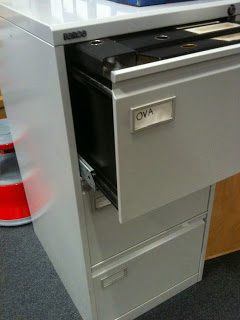On just being in the library

Jenny Jones, Stuart Hall Library volunteer
I have been a volunteer at the Stuart Hall Library since first volunteering during Library Closed week in August 2013. After visiting the powerful Kimathi Donkor exhibition Queens of the Undead, I attended the Reading Group, several Research Network meetings and the Stuart Hall Library Symposium.
The Stuart Hall Library supports exhibitions at Iniva by providing a display of reading
matter and a bibliography related in theme to the current artists on show. The space designed by David Adjaye, features an installation by Ansuman Biswas that is sensitive to the movements of its inhabitants and I always find it unfailingly exhilarating and expansive here. Walking through the door makes me feel in touch with international artists all over the world and those from the past. No matter what my duties are that day, whether the satisfaction of shelf tidying, listing archive contents or merely perusing books, journals and zines I come across, the propensity for synchronicity and inspirational connections is extremely stimulating.
To say that the library gives an opportunity to study the
histories and geographies of art that my BA in Fine Art did not cover is a huge
understatement. My intention is to use the library to expand upon and question my existing knowledge of the myriad ways art is inflected and
shaped by notions of race, ethnicity and culture. This encyclopaedic collection and gentle, inviting space nurtured by Library Manager Sonia Hope, is a much needed sanctuary for such an inquiry.
I have recently enjoyed helping to list some of the backlog of archive material the library holds. This included fascinating documentation of the arts organisation OVA: Organisation of Visual Arts. This organisation based in South London during the 1980s, 1990s and 2000s, supported artists working on the margins of the mainstream Western Art during the development of ideas of the “Global Turn”. This term describes a wider recognition and
acceptance of “multiple modernities” and the fact that art and culture had been negotiated locally in every culture whilst the West’s gaze had been turned inwards at itself.
A useful book for understanding these ideas is The Global Contemporary and the Rise of New Art Worlds, edited by Hans Belting, Andrea Buddensieg and Peter Weibel (library shelf no. 430.127 GLO). This enabled me to piece together the various fragments of what I knew from my education in fine art, feminism and cultural studies about Modernism and the Other. I discovered just how overridingly the West had produced an
interlocking system of capitalism, colonialism, slavery and racism that created
500 years of hegemony. The revelation that “Modern Art” as the sign of creative destruction and innovation was its cultural expression and therefore
insidiously and inextricably tied in with something as seemingly disconnected
as racism was an eye-opening connection. The fact that domestic, everyday and institutional racism is an ideological justification for this system’s strategic inequality and drive to politically control and engineer the world’s agricultural, mineral and labour assets, is mindblowing.
It was a privilege to get an insight into the day to day
running of OVA through its correspondence between artists, curators and staff at various galleries in Britain, Canada and Japan. There were artists CVs, slides, artists flyers and catalogues, also copious evidence of grant applications. I gleaned a picture of how publications and large scale, influential exhibitions came into being; shaping our cultural and historical field. In this sense, the functioning of OVA can be seen as an incredibly important project illustrating ideas of the “postethnic” whereby art is seen as
drawing on the formal language and intellectual tradition of its country of
origin, whilst being simultaneously embedded in international discourses. The
careful contextualising processes unstintingly carried out by OVA’s curators Sunil Gupta and Edward Ward took the form of “rewriting” and questioning the West’s dominance over the world.
One of the aspects I found interesting in the OVA files was the process whereby OVA’s production became digitised. A number of individuals, including those responsible for setting up Iniva, formed a consortium and there was an efflorescence of correspondence around names for this group such as “Gather” and “Pomegranate”. Each drew up a list of artists and curators they felt should be preserved in the forthcoming digital archive. All the necessary operations of power in historicising, or in this case rewriting, are there tucked away in a small grey filing cabinet.

The OVA collection. The collection is not yet available to the public.
Jenny gained a BA in Fine Art-Painting at West Surrey College of Art and Design, a Postgraduate Diploma in Art Therapy and an MA in Feminist History, Theory and Criticism of Art at Leeds University. Her career has involved teaching art at Lambeth, Wandsworth and Southwark Adult Education, facilitating multi-media arts workshops with people with Learning Disabilities at Action Space, and lecturing in Cultural Studies for Art and Design at Croydon College, Northbrook College, the American Intercontinental University and the London College of Fashion. She was a contributing writer and co-editor of Art Therapy, Race and Culture published by Jessica Kingsley and has written for Artist and Illustrator, Make, Fold, Convergence and n.paradoxa.
Recent exhibitions have included “A New (Age) Spirit in Painting” for the ASC windowspace and also the Dulwich Artists Open Houses. She has also curated “Lodgistics” for College Lodge, SE21 and a two day event “AEthereal” at Franklin’s, SE22 for Yuki Miyake’s Open Draw gallery.